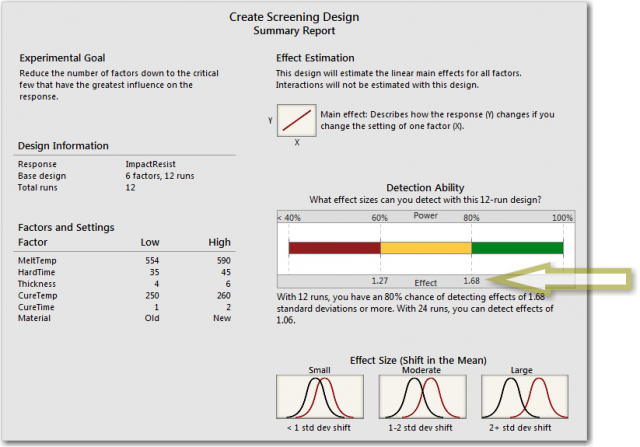

#DOE MINITAB SOFTWARE#
We have to use a different model to model curvature and that model is called response surface methods.Statistical software applications are often used when doing Design of Experiments studies. It is significant from that nova table, therefore the factorial design will fail us. That's a true response curve, as you can see it's not a straight line, it's a curve in both cases, so there is curvature. In the main effects, we see much more clearly the true response is from this dot, connect the dots. Similarly for the other line, it's a curve. The real response is between the low, the center to the high setting. Here we have the interaction plot where the center point is the dot that we see here, based on the legend it's brown or red and we see that it does not rest on the line, so there is curvature in the response. Go up to stat menu, DOE, factorial, factorial plots. It's no longer a straight line between a low and high level settings. That means that there is curvature in the response. Since we had center points, the DOE model tested for curvature and the p value is significant, less than 0.05. But more importantly, the last line here, we have curvature. Here we see that nova table with p values that are very significant in the terms as well as the interactions between concentration and temperature. Then we have the session window, let's make this bigger, with the details of the results. We have the residual plots, look pretty decent, not the world's greatest but normal enough. Graphs, ask for the four in one residuals, for the effects pareto is good enough, okay and okay. Literally the center of the low and high values of all factors and these are the results.


In the worksheet is that center points are indicated by zero and if you notice the values 4.75 is in the middle of 3.75 and 5.75 and 157.5 degrees is between 152.5 and 162.5. That being said, let me just point out something real quick. The response is whiteness, our terms are already there and one quick note, include center points in the model. To analyze this DOE, we have to go up to stat, DOE, factorial, analyze factorial design.
#DOE MINITAB DOWNLOAD#
But wait, we have the results of the experiment already created, so let's go up to the exercise files and download DOECurvature.mtw and open that file, you have the whiteness results in C7.

Here we have the nine runs in standard order, no results yet. Go to options, typically we would randomize runs in the real experiment, but to have consistent easy follow along for this course, let's un-randomize it and click okay. Temperature is our second factor, it's numeric also, 152.5 as the low setting and 162.5 for the high setting. The factors are, type in concentration, and we have that at 3.75% and 5.75% for the high.
#DOE MINITAB PLUS#
We have our two factors and the design we want is one with five center points and one replicate which means two to the power of two is four, four plus five is nine, so we should expect nine runs. To do that, go up to the stat menu, DOE, factorial, create factorial design. We need to create the worksheet for the DOE with the two factors, one replicate and five center points. To get started, open up minitab with a clean worksheet. Now, let's run this factorial design with centerpoints using minitab. The center points are the middle values of both variables, in this case, concentration at 4.75% and temperature at 157.5 degrees. To do this, create an experimental design with one replicate and five center points. If you suspect that there is curvature in the response, design the experiment with center points. For this example, the selected low and high levels of the factors are in this table. So a two to the power of two factorial design is selected. The center of bleach concentration and temperature on the whiteness of the paper, whiteness being the response. What if the CTQ requirement for paper is whiteness? In order to determine optimal settings, a pulp and paper manufacturer wants to study the effects of two variables. This is done by including center points when creating a 2K factorial design. To evaluate whether the model has any significant quadratic components, we need to test for curvature. A second order or quadratic equation is required, where the Y=f(x) is not a straight line or a flat surface. What if it's not a straight line and there is curvature? In that case, a first order model is inadequate and will not be valid. Here is the form of a first order equation, showing the many facts and interaction. We see that Y=f(x) is a first order equation. In 2K factorial designs, the assumption is that the response Y maps to a straight line equation between the low and high settings of the axis.


 0 kommentar(er)
0 kommentar(er)
